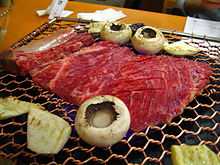Korean barbecue
| Gogigui | |
 | |
| Korean name | |
|---|---|
| Hangul | 고기구이 |
| Hanja | n/a |
| Revised Romanization | gogigui |
| McCune–Reischauer | kogikui |
The Korean barbecue refers to the Korean method of roasting beef, pork, chicken, or other types of meat. Such dishes are often prepared at the diner's table on gas or charcoal grills that are built into the table itself. Some Korean restaurants that do not have built-in grills provide portable stoves for diners to use at their tables.
The most representative form of gogigui is bulgogi usually made from thickly sliced beef sirloin or tenderloin. Another popular form of it is galbi made from marinated beef short ribs.[1] However, gogigui also includes many other kinds of marinated and non-marinated meat dishes, and can be divided into several categories. Korean barbecue is not only popular among Koreans, but has gained popularity internationally.
Types


| Meat | Marinated | Non-marinated |
|---|---|---|
| Beef |
|
|
| Pork |
|
|
| Chicken |
|
|
Marinated gogigui
.jpg)

Bulgogi is the most popular variety of Korean barbecue. Before cooking, the meat is marinated with a mixture of soy sauce, sugar, sesame oil, garlic, and pepper. It is traditionally cooked using gridirons or perforated dome griddles that sit on braziers, but pan-cooking has become common as well.
Galbi is made with beef short ribs, marinated in a sauce that may contain soy sauce, water, garlic, sugar, and sliced onions. It is believed to taste best when grilled with charcoal or soot (숯, burned wood chips).
Jumulleok is short steak marinated with sesame oil, salt and pepper. It is almost similar to non-marinated gogigui and one thing that distinguishes it from other kinds is its steaklike juicy texture. Spicy pork daeji bulgogi is also a popular gogigui dish and it is quite different from beef bulgogi because the marinade is not soy sauce-based, but instead consists of sauces based on "gochujang" and/or "gochu garu" (Korean chili powder).
Non-marinated gogigui


Chadolbegi is a dish made from thinly sliced beef brisket, which is not marinated. It is so thin it cooks nearly instantly as soon as it is dropped onto a heated pan.
Samgyeopsal basically comprises thicker strips of unsalted bacon (pork belly). It has a lot of fatty areas and is tender. In Korea, samgyeopsal is eaten more frequently than chadolbegi due to the comparatively lower price of pork.
Also loins (deungshim, 등심) and boneless ribs (갈비살) are a popular choice for non-marinated type of gogigui.
Side dishes served with gogigui
.jpg)
Gogigui comes with various banchan (side dishes), among which, green onion salad called Pajori and a fresh vegetable dish including lettuce, cucumbers, and peppers invariably accompanies meat dishes at restaurants. A popular way of eating Korean barbecue is to wrap the meat with lettuce and add condiments such as - pajori (spicy scallion salad) and ssamjang (a spicy paste made of doenjang mixed with gochujang).
See also
References
- ↑ Although beef galbi is the most common form of galbi, galbi may also be made from pork ribs or chicken.
- 구이 (in Korean). Doosan Encyclopedia. Retrieved 2008-03-15.
- 구이 (in Korean). Empas/EncyKorea. Retrieved 2008-03-15.
- 구이 (in Korean). Empas/Encyclopædia Britannica. Retrieved 2008-03-15.
External links
| Wikimedia Commons has media related to Korean barbeque. |
- How to Cook Korean Food at Home - The Official Korea Tourism Guide Site
| |||||||||||||||||||||||||||||